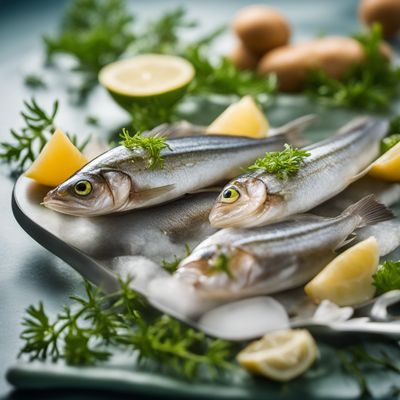
Ingredient
Herrings, sardines, anchovies
"The Trio of Ocean Delights: Exploring the World of Herrings, Sardines, and Anchovies"
Herrings, sardines, and anchovies are all small, oily fish that share similar characteristics. They have a rich, distinctive taste and a firm texture. Herrings are known for their mild flavor, while sardines have a slightly stronger taste. Anchovies, on the other hand, have an intense, salty flavor. These fish are typically silver in color with a streamlined shape and are often enjoyed in various forms, such as canned, smoked, or pickled.
Origins and history
Herrings, sardines, and anchovies have a long history dating back to ancient times. Herrings were highly valued in Northern Europe and were a staple food for many civilizations. Sardines have been enjoyed in Mediterranean cuisine for centuries, particularly in countries like Spain and Portugal. Anchovies have been used in cooking since ancient times, with evidence of their consumption found in ancient Rome and Greece.
Nutritional information
These fish are rich in omega-3 fatty acids, which are beneficial for heart health. They are also a good source of protein, vitamins, and minerals. A serving of herrings, sardines, or anchovies provides a significant amount of essential nutrients while being relatively low in calories.
Allergens
Some individuals may be allergic to fish, including herrings, sardines, and anchovies.
How to select
When selecting herrings, sardines, or anchovies, look for fish that have bright, clear eyes, shiny skin, and a fresh, oceanic smell. Avoid fish with dull eyes, discolored skin, or a strong fishy odor.
Storage recommendations
To maintain the freshness of herrings, sardines, or anchovies, store them in airtight containers in the refrigerator. They are best consumed within a few days of purchase.
How to produce
While it may be challenging for amateurs to produce herrings, sardines, or anchovies on their own, they can try their hand at pickling or smoking these fish at home.
Preparation tips
These fish can be enjoyed in various ways. They can be grilled, baked, fried, or even eaten raw in dishes like sushi or ceviche. When using canned versions, rinse them under cold water to remove excess salt or oil before incorporating them into recipes.
Culinary uses
Herrings, sardines, and anchovies are commonly used in a variety of dishes. They can be added to salads, pasta sauces, pizzas, or used as a topping for bruschetta. They are also popular in Scandinavian cuisine, where they are often pickled or smoked.
Availability
Herrings, sardines, and anchovies are commonly available in coastal regions and countries with access to the ocean. They are cultivated and harvested in areas such as Scandinavia, Spain, Portugal, and Southeast Asia.






